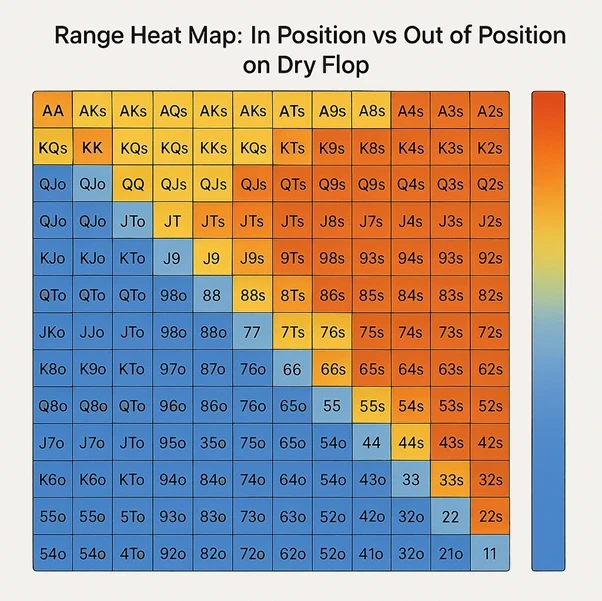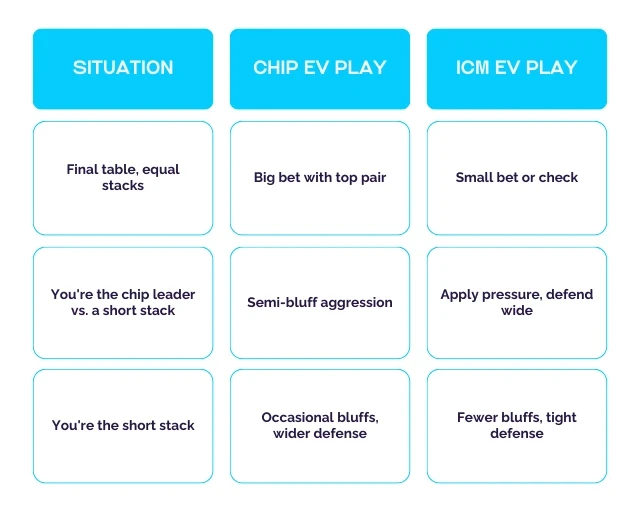You played the pre-flop excellently. But what's next — the flop, turn, river? What's the plan for the next moves at the table? And this is where two scenarios can unfold — either magic or an actual disaster, mainly if you're used to playing poker on autopilot.
Post-flop Poker determines whether you'll leave the table with a profit or hand your chips over to your opponents. Most big pots — and most mistakes — happen after the flop.
But let's move to the good news — you have a helper in the game, and that's GTO Poker. And here, we're not talking about some trendy abbreviation. It's all based on logic, structure, and understanding. This approach will help you make the right and well-balanced decisions in almost any poker hand.
Note: "Right" in GTO does not mean one single best action—solvers often propose several options at varying frequencies, all close to Expected Value. The key is balance, not perfection.
At first, post-flop might seem like true chaos, but with GTO, you'll see the essence and order in the process. With this approach, you'll clearly understand when to bet, how much to bet, and which hands are better to attack with.
However, remember that GTO doesn't prescribe a specific move — it outlines a distribution of plays based on mathematical balance. Your action can depend on how often it should be used rather than being "right" or "wrong”. Most importantly, you base your moves not just on your intuition but on solid and precise math.
Today, we'll try to break everything down — from key points for beginners for successful poker play, to advanced situations with ICM. You'll learn how to play post-flop wisely, simply, and confidently. And the most important thing — we'll talk about various tools, like Optimus Poker, that will make complex decisions even easier. It's time to turn the complex into the simple and move on to Easy Poker.
Core Concepts of Post-Flop GTO Strategy
Okay, the flop has come. Enough of thinking about a particular hand and begin to think in ranges. Range thinking is the main thing in Poker and GTO Poker. Therefore, you are not asking, 'What do I do with KJ?', but rather, 'How do I compare the range that I have versus my opponent's range in that situation?' The foundation of post-flop poker is comparing the strength of ranges and how equity is distributed between them based on the board texture.
In dry flop situations such as A♠7♦2♣, the player in position (IP) usually has an equity advantage. Why? Their range is slightly more aggressive, and the opponent OOP usually lacks strong hands. Thus, the player in position should bet often with small sizing, for instance, 25% of the pot. Doing so will allow you to apply the right amount of pressure on your opponent, take the pot, and minimize the risk of losing money.
Important: Equity advantage is a significant concept, but don't forget about nut advantage and range interaction with specific board textures. Even on dry boards, equity can be close, but betting is often justified due to positional advantage.
Position is vital in this: the player in position can see how the opponent reacts and can adapt. Always think about who has stronger hands in their range on a given board. According to GTO poker strategy, it's essential to keep the following in mind:
- On dry boards (a few draws) — small bets, which should be made frequently.
- On wet boards (many possible draws) — larger bets, less regularly, but more aggressively.
Always make your moves based on who has the equity advantage—the player with the equity advantage should attack.
Also, consider frequency — GTO doesn't always suggest "always bet" or "never bet" but often mixes betting and checking based on solver balance. Studying solver outputs helps understand these bet/check frequencies.

That's precisely how GTO turns a chaotic post-flop into a clear and logical game. First the range, then the board texture, then the sizing — and just like that, you're playing like a reg with a solver in your head.
Post-Flop Bet Sizing and Frequencies
An equally important skill for successful post-flop play is choosing the correct bet size. So, you've opened, called, and waited for the flop. But how much should you bet to avoid making a mistake? This is where most players who use post-flop strategy run into difficulties.
First off, let's clarify: in GTO Poker, there is no such thing as the "correct" bet size. Solvers use mixed sizings — 25%, 50%, 75%, and even overbets. The bet size depends on the board texture and who currently has the equity advantage. Here are a few key points to help you choose the right bet size:
- Small Bets. These are 25% of your pot and are typically perfect for dry boards like K♣8♦3♠. Such bets are great for protection or a cheap bluff. These boards don't offer much for draws, so it's harder for opponents to defend.
- Medium and Large Bets (50-75%). These are chosen when extracting value or putting pressure on vulnerable ranges. On wet boards like J♥T♥9♦, there are many potential draws. As a result, you can bet more to punish weak hands or protect strong ones.
An important note: don't choose your favorite sizing; stick with it for every flop. If you do, your play will become automatic, and opponents will easily read your actions. GTO strategy, on the other hand, involves unpredictable play depending on the situation.
In fact, solvers frequently use mixed strategies — for instance, betting the same hand 25% of the time with one size, 25% with another, and checking the rest. Mastering this idea is key to GTO-level play.
A Small Expert Tip. Many beginners wonder how and when to use different bet sizes. The best way to understand this is using poker solvers like the soon-to-be-launched Optimus Poker. This way, you can see which bet size works on specific boards and the expected profit for each option. This is one of the best ways to learn poker strategy, rather than just copying someone else's play.
If you're still betting the same size on every board, it's time to level up your sizing. It's one of the keys to playing "Easy Poker" — only then will you truly start feeling the game, instead of just betting randomly based on your intuition.

Common Post-Flop GTO Mistakes
GTO Poker is about balance and common sense. But as soon as the flop hits, players start creating absolute chaos in the game. They bluff on bad boards, slow-play strong hands, or forget position. Let's break down the typical mistakes that will prevent you from winning even with a GTO strategy.
- Too much aggression on bad boards. You're on the button, and the flop comes J♠J♥6♠ — and you bet half-pot with air—bad idea. Paired and monotone boards (all the same suit) are dangerous traps for bluffs. Here, GTO usually advises caution: your range is vulnerable, especially against calls from the blinds.
- Ignoring position. If you're out of position (OOP) and your opponent has the range advantage, don't try to seize the initiative. It's often better to check and play defensively than to push forward with weak hands.
- Slow-playing when you should be protecting. Yes, it's nice to hit a set or two pair, but if the board gets dangerous, bet, don't delay. Slow-playing against draws is a direct path to losing.
- Overestimating marginal hands. Top pair with a weak kicker is not your ticket to the bankroll. These hands are often ahead, but not enough to play aggressively across three streets.
Also note: these leaks often come from misunderstanding your range's composition. Use solvers to learn how marginal hands should usually value-bet or check to control pot size.

Tip: Use poker solvers to compare lines and see where you're overdoing it. Even better, practice in Optimus Poker to automatically avoid these traps.
ICM and Tournament Adjustments
In cash games, you treat every chip like a dollar. In tournaments, that's not the case. Welcome to the world of ICM (Independent Chip Model)—a model where the value of your chips depends on other players' stacks. Post-flop GTO strategy changes here as well.
Imagine this. You're at the final table with 12 BB, and behind you are two opponents with 6 and 8 BB. You raise, hit top pair on the flop, and what's next? If you go for thin value (for example, betting large to get value from a weak queen) and get raised, you risk elimination and missing a prize jump. But if you play cautiously, conserve your chips, and wait for the short stack to bust out, you're in the clear.
ICM Tip: When you're a medium or short stack with big stacks at the table, be cautious post-flop. Try to avoid large pots without a firm hand. Sometimes, it's better to under-earn than to overplay a hand and get knocked out.

You're on the button with a stack of 15 BB, and the blinds are 6–8 BB. The flop comes A♦9♣3♠. You raised, and both players called. Instead of betting 70% of the pot (as in Chip EV), bet 25–30% or even check. You conserve your stack and avoid putting yourself at risk of a shove.
Exploiting Leaks Using GTO Baselines
GTO is the foundation. It teaches you to play in a balanced and safe way. But most players aren't solvers. And that's where the fun begins: you can adapt and punish their mistakes.
Instead of unthinkingly following the "perfect" play, look for where your opponent deviates from GTO and adjust accordingly. Here are some common leaks:
- Overfolders — they often give up on the flop. Solution: Bet more often and bluff bolder — even on dry boards;
- Passive callers — they rarely raise, only call. Solution: Don't bluff them on the river, play value bets with bigger sizes;
- Aggressive floaters — they call the flop, then attack the turn. Solution: Check the flop with strong hands, allowing them to bluff.
Tip: If your opponent never check-raises, you can c-bet more often, even with weak hands. GTO requires balance, but against "static" opponents, you can break that balance to your advantage.
Pro insight: deviation from GTO is where the real edge lies. Solvers give you a "defensive strategy". Then, your job is to learn when it's safe to go exploitative and increase EV.
Best Tools to Train Post-Flop Strategy
GTO shows you how to play against a perfect opponent. But since your opponent is human (or a poorly configured bot), play against them, not against the solver.
Understanding post-flop GTO is only half the job. The critical part is reinforcing that knowledge with practice. And that's where Optimus Poker comes in.
Soon, it will be available—an easy and convenient training and learning tool where you can run through real post-flop situations, analyze mistakes, and see how the solver thinks. Everything is visual, interactive, and accessible even for beginners.
You'll see ranges, sizing, frequencies, and most importantly, why this is the best play. It's like GTO but in "Easy Poker" style: play and learn on the go.
Optimus Poker gives you the right tools to master GTO Poker and see how it can help you reach your objectives. Learn, click, analyze, and win.
Conclusion
Post-flop is the part of the game where the fate of most big pots is decided. GTO Poker strategy gives you a clear structure and logic to make the best decisions, even under pressure.
Now you have everything: principles, examples, understanding ranges, sizings, and frequencies. The key is not to overcomplicate. Use the GTO foundation as support, but stay flexible and attentive to your opponents.
With Optimus Poker, you can soon turn GTO into Easy Poker: convenient learning, real situations, and a straightforward interface. No need to get lost in decision trees — learn to play smarter, not harder.
Want to master post-flop without diving into solver complexity? Level up your game soon with Optimus Poker — GTO made easier.
